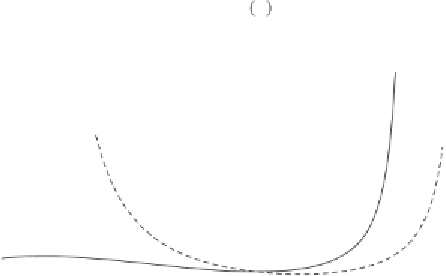Environmental Engineering Reference
In-Depth Information
p
φ
4
3
2
1
φ
0.4
0.6
0.8
1.2
Figure 3.7. Comparison between the pdfs under additive (continuous curve) and
multiplicative (dotted curve) periodic forcing of the Verhulst model (
β
=
1,
=
0
.
5,
T
=
5).
observed in the case of multiplicative random forcing (see Fig.
3.4
) is really noise
induced.
3.2.1.4 Noise-induced transitions driven by dichotomous noise with feedback
In Section
2.2
, we introduced the case of state-dependent dichotomous noise, i.e.,
DMN with transition rates
k
1
and
k
2
dependent on the state
of the system. We also
explained how this type of dependency may arise from (and account for) positive or
negative feedback between the stochastic driver and the state of the system. In this
subsection we show how this feedback (in conjunction with DMN) is able to lead to
qualitative changes in the preferential states of a system with respect to those of the
underlying deterministic dynamics.
The first step toward the identification of noise-induced transitions is again the
recognition of the correct deterministic counterpart of the dynamics. When the func-
tional interpretation is adopted, the deterministic counterpart is the same as the one
for the case with no feedback, in that it is obtained from Eq. (
3.1
), replacing
φ
ξ
dn
(
t
)
with its zero-mean value. In this case the deterministic steady states
φ
st
, are the zeros
of
f
(
0].
Conversely, when themechanistic approach is used, the presence of feedback affects
the steady states of the deterministic dynamics. We recall that in the mechanistic usage
of the DMN the dynamics switch between the two states, depending on whether a
random variable
q
is above or below a threshold value
φ
) [i.e., the solutions of
f
(
φ
st
)
=
θ
:
f
1
(
d
d
t
=
φ
≥
θ
.
)if
q
(
t
)
(3
36a)
,
φ
<θ
.
f
2
(
)if
q
(
t
)
(3
36b)











Search WWH ::

Custom Search